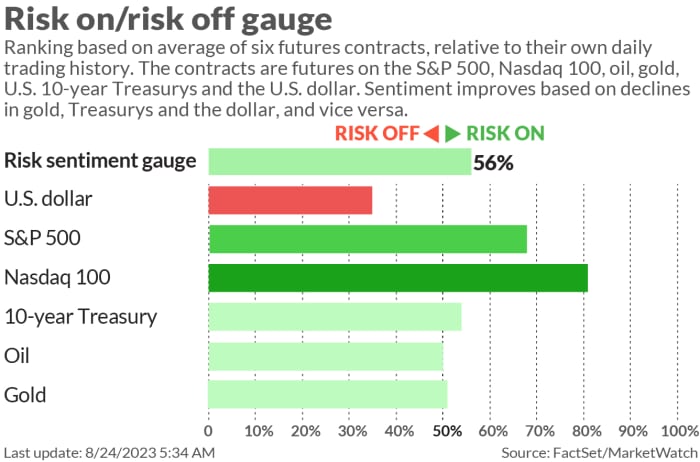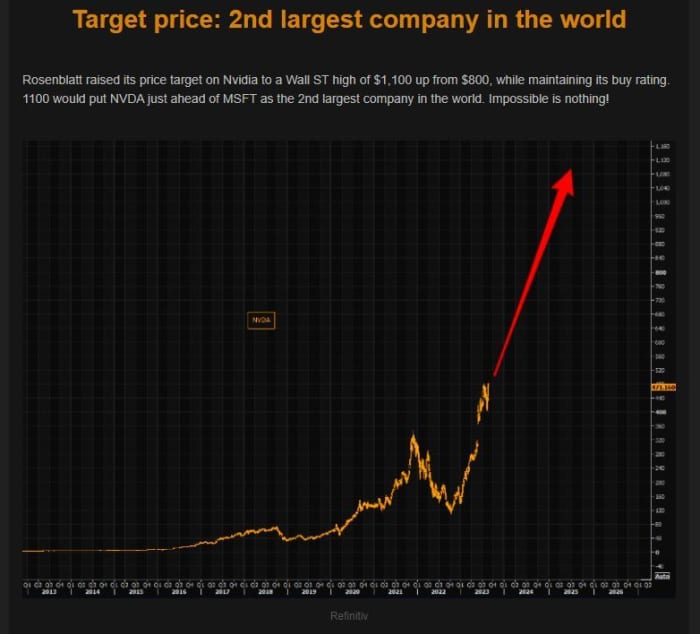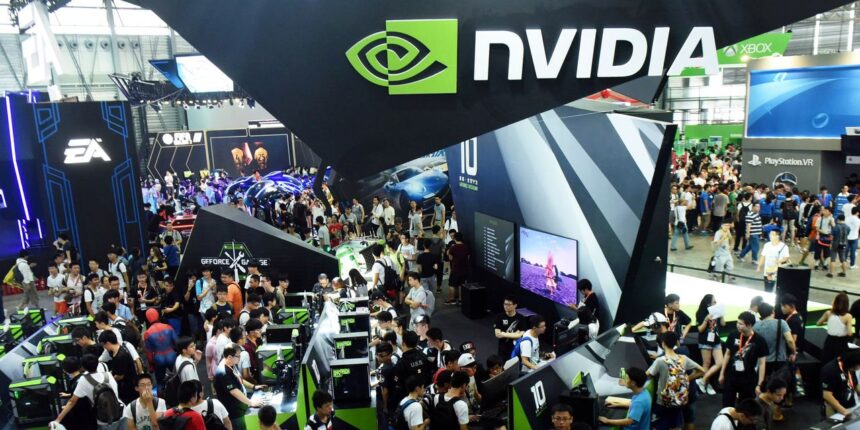Those hoping for dazzling Nvidia results were not disappointed and shares are pointing to a fresh record for Thursday. And the AI leader looks like the tide lifting all boats, with the tech sector set to explode and S&P 500
gain when Wall Street opens.
Will Nvidia drive a new bull market for Wall Street? First, we’ll have to wait until Friday’s speech from Fed Chair Jerome Powell in Jackson Hole.
But investors likely have more burning questions around Nvidia
NVDA,
and rightly so.
For our call of the day, we return to Inge Heydorn, partner on the GP Bullhound Global Technology Fund and portfolio manager Jenny Hardy to weigh in on the investing pros and maybe cons on Nvidia and some of its rivals.
Their fund has been invested in Nvidia for at least three years, along with other big names in the space such as Advanced Micro Devices
AMD.
MarketWatch spoke to the pair via email and telephone on Thursday, with this first big question: Is it to late to invest in Nvidia now?
“In the next six months, I think it will be good to invest in Nvidia, but you need to be aware that the risk is quite high,” Heydorn told MarketWatch by phone. Shares of the chip maker have already soared 222% this year, which harks back to a 223% gain in 2016.
However, the pair say there is a better alternative to consider. “AMD is clearly a safer play,” Heydorn says, though he thinks the “market itself around AI is going to perform very, very strongly.” Shares of AMD are up a mere 68% so far this year, not even touching a nearly 300% surge in 2016.
While Nvidia is obviously the “clearest direct beneficiary of the AI build…the reality is that no hyperscaler wants to be tied into one supplier (it is no secret that Nvidia chips are very highly priced),” adds Hardy in an email.
“We think that AMD is the most obvious alternative and to the extent that they can ramp supply of their GPU this year, they will absolutely benefit from the current supply shortage in the market and cement themselves as a credible alternative,” she says.
“While it’s true that Nvidia will likely become the de facto standard in training, the inference market is likely much bigger with more varied workloads that AMD can build a position in. More broadly Nvidia chips need to be made at TSMC [Taiwan Semiconductor Manufacturing Co.
TSM
] , using ASML
ASML
tools, so there are clear second derivative impacts on the broader value chain,” says Hardy. Both ASML and Taiwan Semi rose in premarket trade.
Nvidia is seen as a leader in the market for one type of chips, those that train systems to generate models, while inference chips, interpret trained models and respond to user questions. As noted by Techspot in January, the latter segment “is much bigger and no single entity, not even Nvidia, has a lock on this market.”
Opinion: These AI-chip startups hope to challenge Nvidia, but it may take some time
And what about those investors who have been holding Nvidia long enough to see some tidy profits? How will they know when it’s time to take some profit off the table?
That is tough to answer, says Heydorn. But one big selling point for Nvidia is its “extraordinary” low leverage — the company had $6.8 billion in incremental revenue year over year, with less than $100 million incremental operating expenditure, he and Hardy note.
Read: Will Powell crush stocks again during Friday’s Jackson Hole speech? Here’s one reason investors shouldn’t worry.
The markets

Risk on. Nasdaq 100 futures
NQ00
are up 1.2%, with S&P 500 futures
ES00
also climbing on tech-fueled momentum, while Treasury yields
are inching up after hitting one-week highs on Wednesday. Asia stocks were higher, led by a 2% gain for Hong Kong’s Hang Seng Index
.
For more market updates plus actionable trade ideas for stocks, options and crypto, subscribe to MarketDiem by Investor’s Business Daily.
The buzz
Nvidia
NVDA
shares are pointing to a fresh record high following a 141% surge in data-center sales and record results, and Wall Street is ratcheting up its price targets. Shares of AI-rival Advanced Micro Devices
AMD
and semiconductor foundry Taiwan Semi
TSM
are getting a boost as well, along with European chip groups, such as ASM International
NL:ASM.
Opinion: Nvidia’s jaw-dropping revenue forecast might not even be its peak
Boeing
BA
is down 1.7% in premarket after supplier Spirit AeroSystems
SPR
said there was a new defect on the troubled 737 Max aircraft. Spirit shares are down 6%.
Cut-price retailer Dollar Tree
DLTR
fell as its current quarter earnings guidance lagged Wall Street estimates, with Ulta Beauty
ULTA
and Intuit
INTU
coming after the bell.
Also reporting late Wednesday, in the software space, Splunk
SPLK
and Autodesk
ADSK
are surging on upbeat results. Retailer Guess
GES
rallied more than 13% after topping Wall Street expectations.
Weekly jobless claims and durable goods orders are both due at 8:30 a.m., with some Fed interviews from the Jackson Hole gathering expected around 10 a.m.
Best of the web
All the highlights from the Republican presidential primary, with former Ambassador Nikki Haley among those scoring points. And here are some of the most viral moments.
Can BRICS dethrone the U.S. dollar? It’ll be an uphill climb, experts say
Despite cheating, U.S. schools are repealing ChatGPT bans
The chart
Wall Street is ratcheting up share price targets on Nvidia. The Market Ear points out what one bullish analyst’s call means for the stock:

The Market Ear/Refinitiv
The tickers
These were the top-searched tickers as of 6 a.m. Eastern:
| Ticker | Security name |
| NVDA | Nvidia |
| AMC | AMC Entertainment |
| TSLA | Tesla |
| MULN | Mullen Automotive |
| APE | AMC Entertainment preferred shares |
| GME | GameStop |
| AAPL | Apple |
| NIO | NIO |
| PLTR | Palantir |
| AMD | Advanced Micro Devices |
Random reads
An injured Kevin Hart says he’s the ‘dumbest man alive’ for not acting his age.
World first? Spotless baby giraffe born at Tennessee zoo.
Need to Know starts early and is updated until the opening bell, but sign up here to get it delivered once to your email box. The emailed version will be sent out at about 7:30 a.m. Eastern.
Listen to the Best New Ideas in Money podcast with MarketWatch financial columnist James Rogers and economist Stephanie Kelton.








